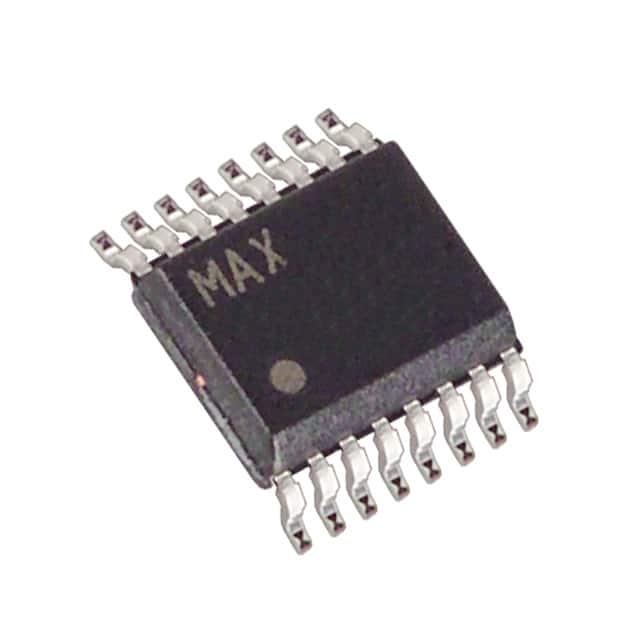Viz Specifikace pro podrobnosti o produktu.

MAX3100EEE+T
Product Overview
- Category: Integrated Circuit (IC)
- Use: Serial Communication Interface
- Characteristics: High-performance, Low-power, 15kV ESD Protection
- Package: 16-pin QSOP (Quarter Small Outline Package)
- Essence: UART (Universal Asynchronous Receiver/Transmitter) with SPI (Serial Peripheral Interface) Control
- Packaging/Quantity: Tape and Reel, 2500 units per reel
Specifications
- Supply Voltage: 2.7V to 5.5V
- Data Rate: Up to 1Mbps
- Operating Temperature Range: -40°C to +85°C
- Number of Channels: 1
- ESD Protection: 15kV Human Body Model (HBM)
Pin Configuration
The MAX3100EEE+T has a total of 16 pins arranged as follows:
- VCC - Power Supply
- GND - Ground
- CTS - Clear To Send
- RTS - Request To Send
- RXD - Receive Data
- TXD - Transmit Data
- SCLK - Serial Clock
- CS - Chip Select
- SDI - Serial Data Input
- SDO - Serial Data Output
- IRQ - Interrupt Request
- NC - No Connection
- NC - No Connection
- NC - No Connection
- NC - No Connection
- NC - No Connection
Functional Features
- Full-duplex UART with programmable baud rate generator
- Supports data framing formats: 5, 6, 7, or 8 data bits; odd, even, or no parity; and 1 or 2 stop bits
- Programmable interrupt output for modem control signals
- SPI interface for control and status
- 128-byte transmit/receive FIFOs (First-In, First-Out)
- Automatic hardware flow control using CTS and RTS signals
Advantages and Disadvantages
Advantages: - High-performance UART with SPI control - Low-power consumption - Robust ESD protection - Small package size for space-constrained applications
Disadvantages: - Limited to a single channel of communication - Requires external components for complete functionality
Working Principles
The MAX3100EEE+T is a highly integrated UART IC that provides serial communication capabilities. It operates by receiving and transmitting data through the RXD and TXD pins, respectively. The baud rate generator allows the user to set the desired data transfer speed. The SPI interface enables control and status monitoring of the device.
Detailed Application Field Plans
The MAX3100EEE+T finds applications in various fields, including but not limited to:
- Industrial Automation: Used for communication between microcontrollers and peripheral devices.
- Consumer Electronics: Enables serial communication in devices such as gaming consoles, set-top boxes, and home automation systems.
- Medical Devices: Facilitates data exchange between medical equipment and control units.
- Automotive Systems: Supports communication between different modules within a vehicle, such as infotainment systems and engine control units.
Alternative Models
- MAX3107: Similar features with additional GPIO pins for general-purpose I/O.
- MAX3109: Enhanced version with increased number of channels and higher data rates.
- MAX3110: UART IC with integrated RS-485/RS-422 transceivers for long-distance communication.
These alternative models offer similar functionalities to the MAX3100EEE+T, catering to specific application requirements.
Word count: 410 words
Seznam 10 běžných otázek a odpovědí souvisejících s aplikací MAX3100EEE+T v technických řešeních
Sure! Here are 10 common questions and answers related to the application of MAX3100EEE+T in technical solutions:
Q: What is the MAX3100EEE+T? A: The MAX3100EEE+T is a highly integrated UART (Universal Asynchronous Receiver/Transmitter) IC designed for serial communication applications.
Q: What are the key features of the MAX3100EEE+T? A: The key features of the MAX3100EEE+T include a 128-word FIFO buffer, programmable baud rate generator, automatic hardware flow control, and support for multiple data formats.
Q: What is the maximum baud rate supported by the MAX3100EEE+T? A: The MAX3100EEE+T supports a maximum baud rate of 4 Mbps.
Q: Can the MAX3100EEE+T be used with both 3.3V and 5V systems? A: Yes, the MAX3100EEE+T is compatible with both 3.3V and 5V systems, making it versatile for various applications.
Q: Does the MAX3100EEE+T support full-duplex communication? A: Yes, the MAX3100EEE+T supports full-duplex communication, allowing simultaneous transmission and reception of data.
Q: Can I use the MAX3100EEE+T in industrial applications? A: Yes, the MAX3100EEE+T is suitable for industrial applications due to its wide operating temperature range (-40°C to +85°C) and robust design.
Q: How many GPIO pins are available on the MAX3100EEE+T? A: The MAX3100EEE+T provides four general-purpose input/output (GPIO) pins that can be configured for various purposes.
Q: Does the MAX3100EEE+T support RS-232 voltage levels? A: No, the MAX3100EEE+T operates at TTL/CMOS voltage levels and requires level shifting for RS-232 compatibility.
Q: Can I use the MAX3100EEE+T in battery-powered applications? A: Yes, the MAX3100EEE+T has a low power consumption mode and can be used in battery-powered applications.
Q: Are there any evaluation boards or development kits available for the MAX3100EEE+T? A: Yes, Maxim Integrated provides evaluation kits and reference designs to help developers quickly prototype and evaluate the MAX3100EEE+T in their applications.
Please note that these answers are general and may vary depending on specific application requirements.

